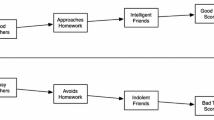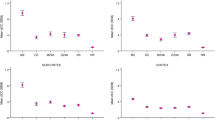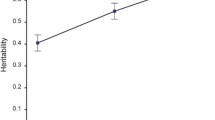Abstract
Thirty-four pairs of Swedish fraternal twins separated in the first 10 years of life were administered 12 tests of cognitive abilities. The average age of the twins was 59 years. Nineteen pairs were separeted before the first year of life and 26 pairs (76%) were separated by the age of 5 years. Moderate positive twin correlations were found for all tests, reaching significance for Raven's Progressive Matrices and Word Beginnings and Endings. A twin correlation of 0.52 emerged for the first principal component (a measure of general ability). Moderate correlations were found for Spatial Ability and for Verbal Ability/Perceptual Speed factors; for the Memory factor the correlation was lower. The effect of early environment on cognitive ability was assessed by analyzing the association between a degree of separation index and twin resemblance. The importance of the separation measures taken individually was also examined. Some significant effects were found, but these were consistently in a counterintuitive direction: Twins separated earlier weremore similar than those separated later.
Similar content being viewed by others
References
Bouchard, T. J. (1983). Do environmental similarities explain the similarity in intelligence of identical twins reared apart?Intelligence 7:175–184.
Bouchard, T. J., and McGue, M. (1981). Familial studies of intelligence: A review.Science 212:1055–1059.
Cederlöf, R. (1966).The Twin Method in Epidemiological Studies on Chronic Disease, Doctoral dissertation, University of Stockholm, Stockholm.
Cederlöf, R., Friberg, L., Jonsson, E., and Kaij, L. (1961). Studies on similarity diagnosis in twins with the aid of mailed questionnaires.Acta Genet. Med. Gemellol. 11:338–362.
Cohen, J. (1977).Statistical Power Analysis for the Behavioral Sciences, Academic Press, New York.
Cohen, J., and Cohen, P. (1975).Applied Multiple Regression/Correlation Analysis for the Behavioral Sciences, Halstead Press, New York.
Crumpacker, D. W., Cederlöf, R., Friberg, L., Kimberling W. J., Sörensen, S., Vandenberg, S. G., Williams, J. S., McClearn, G. E., Grevér, B., Iyer, H., Krier, M. J., Pedersen, N. L., Price, R. A., and Roulette, I. (1979). A twin methodology for the study of genetic and environmental control of variation in human smoking behavior.Acta Genet. Med. Gemellol. 28:173–195.
DeFries, J. C., Vandenberg, S. G., and McClearn, G. E. (1976). Genetics of specific cognitive abilities.Annu. Rev. Genet. 19:179–207.
DeFries, J. C., Johnson, R. C., Kuse, A. R., McClearn, G. E., Polovina, J., Vandenberg, S. G., and Wilson, J. R. (1979). Familial resemblance for specific cognitive abilities.Behav. Genet. 9:23–43.
DeFries, J. C., Plomin, R., Vandenberg, S. G., and Kuse, A. R. (1981). Parent-offspring resemblance for cognitive abilities in the Colorado Adoption Project: Biological, adoptive, and control parents and one-year-old children.Intelligence 5:245–277.
Farber, S. L. (1981).Identical Twins Reared Apart: A Reanalysis, Basic Books, New York.
McGue, M., and Bouchard, T. J. (1984). Adjustment of twin data for the effects of age and sex.Behav. Genet. 14:325–343.
Medlund, P., Cederlöf, R., Floderus-Myrhed, B., Friberg, L., and Sörensen, S. (1976). A new Swedish Twin Registry.Acta Med. Scand. Suppl. 600.
Partanen, J., Bruun, K., and Markkanen, T. (1966).Inheritance of Drinking Behavior, Finnish Foundation for Alcohol Studies, Helsinki.
Pedersen, N. L., Friberg, L., Floderus-Myrhed, B., McClearn, G. E., and Plomin, R. (1984). Swedish early separated twins: Identification and characterization.Acta Genet. Med. Gemellol. 33:243–250.
Plomin, R., and DeFries, J. C. (1980). Genetics and intelligence: recent data.Intelligence 4:15–24.
Price, R. A., and Vandenberg, S. G. (1980). Spouse similarity in American and Swedish couples.Behav. Genet. 10:59–71.
Reiss, A. J. (1961).Occupations and Social Status, Free Press, Glencoe, Ill.
Sarna, S. (1977).Zygosity Diagnosis in Epidemiological Twin Studies: By Blood Markers and by Questionnaire, University of Helsinki Press, Helsinki.
Schoenfeldt, L. F. (1968). The nereditary components of the Project TALENT two-day test battery.Meas. Eval. Guidance 1:130–140.
Snedecor, G. W., and Cochran, W. G. (1967).Statistical Methods, Iowa State University Press, Ames.
Taylor, H. F. (1980).The IQ Game: A methodological Inquiry into the Heredity-Environment Controversy, Rutgers University Press, New Brunswick, N.J.
Vandenberg, S. G., and Johnson, R. C. (1968). Further evidence on the relation between age at separation and similarity in IQ among pairs of separated identical twins. In Vandenberg, S. G. (ed.),Progress in Human Behavior Genetics, Johns Hopkins University Press, Baltimore.
Author information
Authors and Affiliations
Additional information
This research was supported in part by National Institute on Aging Grant AG-01592.
Rights and permissions
About this article
Cite this article
Pedersen, N.L., McClearn, G.E., Plomin, R. et al. Separated fraternal twins: Resemblance for cognitive abilities. Behav Genet 15, 407–419 (1985). https://doi.org/10.1007/BF01070898
Received:
Accepted:
Issue Date:
DOI: https://doi.org/10.1007/BF01070898




